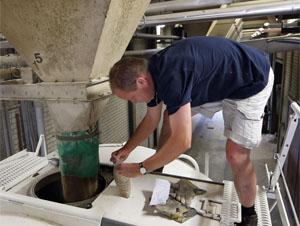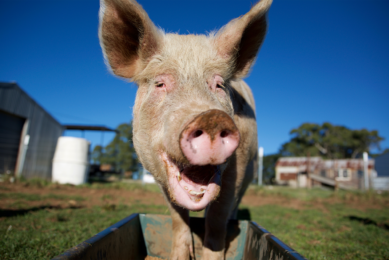Cost-effective and convenient xylanase enzyme analysis

With around 85% of all manufactured monogastric feed thought to contain at least one commercial enzyme product, the success of feed formulations is increasingly dependent on those enzymes delivering performance benefits. A breakthrough in xylanase enzyme analysis confirms enzyme presence and levels.
Dr Hadden Graham, AB Vista Technical Director, Mr Noel Sheehan, Enzyme Services and Consultancy (ESC) Manager.
For the feed manufacturer, being able to test the resulting feeds to a sufficiently high standard to ensure correct enzyme dosage and activity is an important part of quality control and assurance procedures. If dietary energy levels are to be reduced following addition of a xylanase, for example, it is vital that the actual amount of enzyme present and active in the feed is as expected. Since any failure to achieve this will likely to result in significant reduction in animal performance, and subsequent financial loss, there is a need for regular and accurate analysis of manufactured feed to confirm enzyme presence and levels.
Enzyme testing
Yet despite more than US$700 million being spent annually on feed enzymes, either to release additional nutrients from feed ingredients or reduce anti-nutritive effects, testing for enzymes within finished diets has until recently been limited to expensive and time-consuming laboratory testing procedures. Not only that, although there is a recognised universal quality control method for phytase analysis, no such methods exist for xylanases, glucanases, proteases or amylases.
In most cases, testing procedures have been developed primarily in response to the requirements of certain regulatory authorities, such as those in the European Union, with little regard for the requirements of a feed industry in need of reliable and accurate feed enzyme testing that’s also convenient and cost-effective. The result has been a number of producer- and product-specific assays that are often both difficult and costly to run independently, and have little practical value to the feed manufacturer or end-user needing a test that’s quick, simple, accurate and low cost.
In addition, current laboratory-based analyses tend to be highly sensitive to small changes in experimental conditions, such as pH, temperature and the composition of any reagents used. The result is potentially large variations in activity readings between different laboratories, leaving the feed producer with little option other than to send samples back to the enzyme supplier each time a quality assurance test is required.
Method limitations
This situation is far from ideal, and was the driving force behind the development by AB Vista of a test procedure that raises the standards for feed enzyme testing by both overcoming these fundamental problems and avoiding many of the shortfalls that currently limit existing test methodologies. For example, previous methods have generally relied on the interaction of an enzyme with a specific substrate under certain fixed conditions (such as pH, temperature, time and substrate concentration), followed by the quantification of the end-products subsequently released.
In other words, such methods only measure enzyme activity under a particular set of predefined conditions. It is virtually impossible to differentiate between the activity resulting from the added enzymes and that from any endogenous enzymes in the feed ingredients, even though these endogenous enzymes may have limited efficacy in the animal, while the added enzymes may be restricted by inhibitors present within the feeds.
Of equal concern is the fact that despite this approach requiring a reasonably sophisticated laboratory set-up and around a day to complete, it is still unable to differentiate between enzymes of the same type but from different sources. In the commercial situation, where enzyme efficacy ranges widely within the animal depending on characteristics that vary with source and level of development, the ability to identify specific enzymes with absolute certainty is important.
In this context, it should also be remembered that no laboratory-based assay method can accurately predict enzyme efficacy in the animal. It is simply not possible to reproduce the exact gastro-intestinal conditions of the target species in a test-tube, a limitation which restricts any in vitro assay to basic quality control purposes.
ELISA development
For these reasons, AB Vista took a very different approach, working with the team at Enzyme Services and Consultancy (ESC) in the UK to establish a new standard for feed enzyme assays that directly measured enzyme presence and activity. The resulting enzyme-linked immuno-sorbent assays (ELISA) are based on the principle of capturing and immobilising the target protein – in this case the active form of a particular feed enzyme – by using a specific antibody that is both highly targeted and highly accurate (Figure 1).
With each ELISA developed for a specific feed enzyme, the antibodies are designed to match a part of the protein which is in, or close to, the intact active site. This avoids mis-detection of any enzyme that has even partially denatured during feed processing, and ensures that both endogenous enzymes and other added enzymes from a different source are also ignored. This in itself is a major advance in the accuracy of feed enzyme testing.
The presence and level of captured protein (i.e. the target enzyme) can then be quantified using a secondary reaction, which produces a colour that can be compared to set standards to determine enzyme levels. The result is a quick, low cost, accurate test that can be carried out anywhere in the world with highly repeatable results, and which is much less sensitive to changes in experimental and environmental conditions than previously used techniques.
Each ELISA can also be adapted to allow for rapid enzyme detection only, or for actual quantification of enzyme levels, and all without the need for any complex equipment or specialised staff.
Unique advantages
It is a unique approach, and this new standard of testing is already proving to be highly successful, with the original AB Vista ELISA for Quantum phytase that was launched previously now joined by a new ELISA for Econase XT xylanase. For both, two types of ELISA kit have been developed, the first being a ‘QuickStix’ lateral-flow kit for the rapid detection that will provide a qualitative test for commercial levels of active enzyme within just five minutes of feed manufacture!
The ‘QuickStix’ kit is capable of detecting enzyme presence in as little as individual feed pellets, making it an excellent quality control tool for feed manufacturers, whilst also being able to demonstrate the survival of an enzyme, for example, during progress through the gastro-intestinal tract. Two red ‘indicator’ marks on each ‘QuickStix’ react to the presence of the extract of a feed sample, with the upper line confirming that the ‘QuickStix’ is working correctly, while the colour intensity of the lower red line is proportional to the level of Econase XT xylanase activity present.
The second test kit is a ‘QuantiPlate’ micro-titre well kit for the accurate quantification of enzyme activity over the range normally found in commercial feeds (see Figure 1). Capable of producing accurate results within three hours, it is designed to be simple and straightforward to use.
Accuracy confirmed
To confirm the accuracy and repeatability of the results, analysis of a range of feeds supplemented with between 0 U/kg (sample 1 in Figure 2) and 48,000 U/kg (sample 8 in Figure 2) Econase XT xylanase was carried out using both the ELISA ‘QuantiPlate’ method and a standard wet chemistry assay. The results showed good agreement between the ‘QuantiPlate’ results and the amount of enzyme expected in the feeds based on the quantity added (R2>0.99, P<0.001), confirming the robustness and value of this new method (Figure 2). The higher readings from the wet chemistry assay were due to it also detecting around 3,000 U/kg of endogenous xylanase activity, something the new ‘QuantiPlate’ assay avoided.
It is clear that both the Econase XT ‘QuantiPlate’ and ‘QuickStix’ tests have a significant role to play in setting a new, higher standard for cost-effective and convenient xylanase enzyme testing. For those feed manufacturers looking to streamline quality control and assurance procedures, and minimise reliance on expensive and time-consuming laboratory testing, there is little doubt that this represents a very substantial step forwards.
AllAboutFeed 21.9











